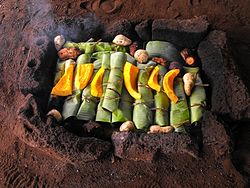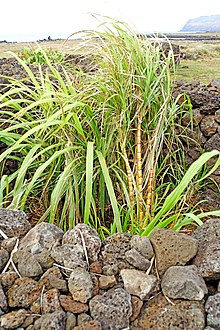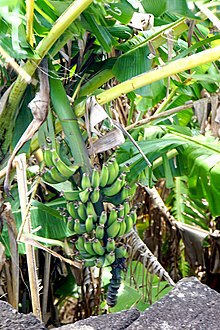 A
Pascuense umu, meat and vegetables roasted in an
earth oven. | |
| Country or region | Easter Island |
|---|---|
| National dish | Umu |

| Part of a series on the |
| Culture of Easter Island |
|---|
 |
| History |
| Languages |
| Cuisine |
| Music |
Pascuense cuisine, otherwise known as Easter Island cuisine or Rapa Nui cuisine incorporates the influences of the indigenous Rapa Nui people and Latin America. Notable ingredients include seafood such as fish, octopus (heke), eel, sea snails (pipi) and crustaceans ( lobster), as well as sweet potato, taro, banana, pineapple, coconut, pumpkin, and poultry, pork and lamb meat. [1]
Traditional foods include umu, meat, fish, vegetables and fruit wrapped in banana leaves and roasted in umu pae – an earth oven. Po'e, pudding made of mashed bananas, pumpkin and flour is baked in the umu pae as well. [1] Other favorite dishes are tunu ahi, fish grilled on hot stones, or ceviche. Pascuense cuisine also includes meat dishes, such as pork or mutton ribs. [2]
History

Easter Island was first settled in 800CE-1200CE by Polynesian explorers from Eastern Polynesia, bringing numerous plant and animal species with them. Some crops such as breadfruit, coconut and kava failed to grow in the subtropical climate. The crops that did thrive were sweet potato (kumara), taro, yams (uhi), bananas (maika), calabash (hue), ti, sugarcane (toa), giant taro (kape), turmeric (pua), arrowroot (pia) and malay apple (haia), [3] [4] as well as chickens (moa) and rats (kiore). Out of the crops introduced, the sweet potato was considered the most important. Vast areas of forest were cleared for agriculture, but with the island’s exposure to wind and periodic droughts, circular stone walls called Manavai were erected to shelter crops and conserve moisture. [5]

Dishes
- Cazuela: A casserole dish adopted from Chile. The Easter Island version contains Polynesian ingredients such as sweet potato and plantain. [6]
- Ceviche: A raw fish dish cooked in citrus juice. Tuna is the preferred fish.
- Empanada: Baked turnover pastry containing fillings. In Easter Island, tuna is the most popular filling.
- Po'e: A traditional pudding made from pounded foods like banana or taro, wrapped in leaves and baked into a thick consistency.
- Sopaipilla: Leavened bread, rolled into a sheet, cut and deep-fried.
- Tunu Ahi: Fish grilled on hot rock.
- Umu: Also known as Umu pae. It is a traditional method of cooking large quantities of food. Leaves and food are layered on hot rocks before covering with soil.
References
- ^ a b "Gastronomía mapuche, aymara y rapanui" (in Spanish). El sitio del patrimonio cultural chileno. August 2004. p. 4.
- ^ "Easter Island, Gastronomy". CHILE TRAVEL & TOURS. Archived from the original on 2012-11-14. Retrieved 2012-01-07.
-
^
Loret, John, Tanacredi, John T. (2003).
Easter Island: Scientific Exploration into the World's Environmental Problems in Microcosm. Kluwer Academic / Plenum Publishers. p. 136.
ISBN
9780306474941.
{{ cite book}}: CS1 maint: multiple names: authors list ( link) - ^ Boersema, Jan J. (2015). The Survival of Easter Island–Dwindling Resources and Cultural Resilience. University of Hawaii Press. p. 55. ISBN 9781107027701.
- ^ Hunt, Terry; Lipo, Carl (1 January 2013). "The Human Transformation of Rapa Nui (Easter Island, Pacific Ocean)". Biodiversity and Societies in the Pacific Islands. pp. 167–184.
- ^ Montecino, Sonia (2010). Fuegos, hornos y donaciones: Alimentación y cultura en Rapa Nui. Editorial Catalonia, Santiago. p. 233. ISBN 9789563246230.